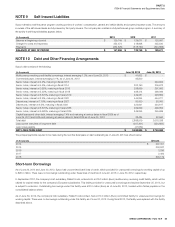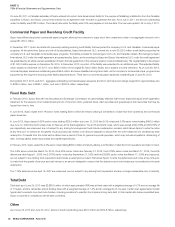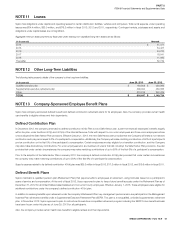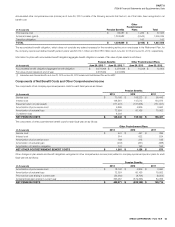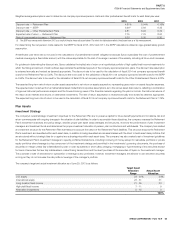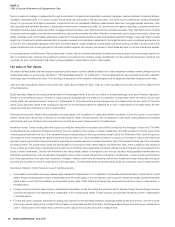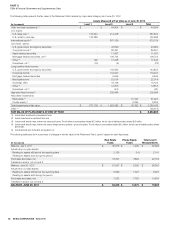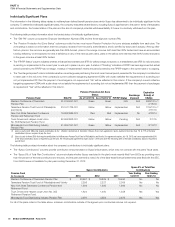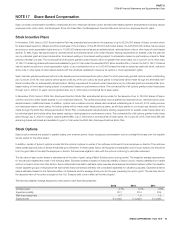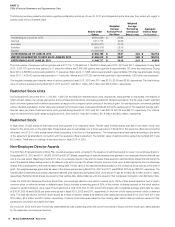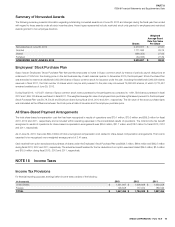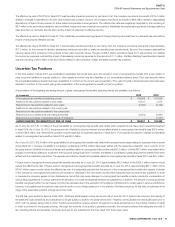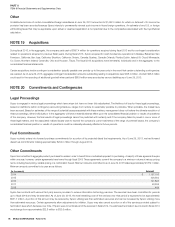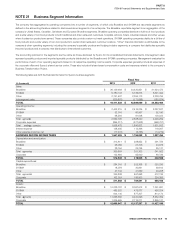Sysco 2013 Annual Report Download - page 80
Download and view the complete annual report
Please find page 80 of the 2013 Sysco annual report below. You can navigate through the pages in the report by either clicking on the pages listed below, or by using the keyword search tool below to find specific information within the annual report.
SYSCO CORPORATION-Form10-K 69
PARTII
ITEM8Financial Statements and Supplementary Data
NOTE14 Multiemployer Employee Benefi t Plans
Defi ned Benefi t Pension Plans
Sysco contributes to several multiemployer de ned bene t pension plans in the UnitedStates and Canada based on obligations arising under collective
bargaining agreements covering union-represented employees. Sysco does not directly manage these multiemployer plans, which are generally managed
by boards of trustees, half of whom are appointed by the unions and the other half by other employers contributing to the plan. Approximately 10% of
Sysco’s current employees are participants in such multiemployer plans as of June29,2013.
The risks of participating in these multiemployer plans are different from single-employer plans in the following aspects:
•Assets contributed to the multiemployer plan by one employer may be used to provide bene ts to employees of other participating employers.
•If a participating employer stops contributing to the plan, the unfunded obligations of the plan may be borne by the remaining participating employers.
•
If Sysco chooses to stop participating in some of its multiemployer plans, Sysco may be required to pay those plans an amount based on the underfunded
status of the plan, referred to as a withdrawal liability.
Based upon the information available from plan administrators, management believes that several of these multiemployer plans are underfunded. In addition,
pension-related legislation in the UnitedStates requires underfunded pension plans to improve their funding ratios within prescribed intervals based on the
level of their underfunding. As a result, Sysco expects its contributions to these plans to increase in the future. In addition, if a UnitedStates multiemployer
de ned bene t plan fails to satisfy certain minimum funding requirements, the Internal Revenue Service (IRS) may impose a nondeductible excise tax of
5% on the amount of the accumulated funding de ciency for those employers contributing to the fund.
Withdrawal Activity
Sysco has voluntarily withdrawn from various multiemployer pension plans. Total withdrawal liability provisions recorded were $41.9million in scal
2013, $21.9million in scal 2012 and $41.5million in scal 2011. As of June29,2013 and June30,2012, Sysco had approximately $40.7million and
$30.7million, respectively, in liabilities recorded related to certain multiemployer de ned bene t plans for which Sysco’s voluntary withdrawal had already
occurred. Recorded withdrawal liabilities are estimated at the time of withdrawal based on the most recently available valuation and participant data for
the respective plans; amounts are subsequently adjusted to the period of payment to re ect any changes to these estimates. If any of these plans were
to undergo a mass withdrawal, as de ned by the Pension Bene t Guaranty Corporation, within the two plan years following the plan year in which we
completely withdraw from that plan, Sysco could have additional liability. The company does not currently believe any mass withdrawals are probable to
occur in the applicable two-plan year time frame relating to the plans from which Sysco has voluntarily withdrawn.
Potential Withdrawal Liability
Under current law regarding multiemployer de ned bene t plans, a plan’s termination, Sysco’s voluntary withdrawal, or the mass withdrawal of all contributing
employers from any underfunded multiemployer de ned bene t plan would require Sysco to make payments to the plan for Sysco’s proportionate share of
the multiemployer plan’s unfunded vested liabilities. Generally, Sysco does not have the greatest share of liability among the participants in any of the plans
in which it participates. Sysco believes that one of the above-mentioned events is reasonably possible for certain plans in which it participates and estimates
its share of withdrawal liability for these plans could have been as much as $80.0million as of June29,2013. This estimate excludes plans for which Sysco
has recorded withdrawal liabilities or where the likelihood of the above-mentioned events is deemed remote. This estimate is based on the information
available from plan administrators, which had a valuation date ofDecember31,2011. As the valuation date for all of these plans was December31,2011,
the company’s estimate re ects the condition of the nancial markets as of that date. Due to the lack of current information, management believes Sysco’s
current share of the withdrawal liability could materially differ from this estimate.
Plan Contributions
Sysco’s contributions to multiemployer de ned bene t pension plans were as follows for each scal year:
(Inthousands)
2013 2012 2011
Individually signi cant plans $ 28,816 $ 29,497 $ 27,196
All other plans 36,923 38,611 6,819
TOTAL CONTRIBUTIONS $ 65,739 $ 68,108 $ 34,015
Payments for voluntary withdrawals included in contributions were $31.8million, $33.6million and zero in scal 2013,2012 and 2011, respectively.
Contributions for individually signi cant plans and all other plans have been presented in the table above for all years based on the current year designation
of individually signi cant plans. Prior periods amounts have been reclassi ed for consistency with the current year presentation.


